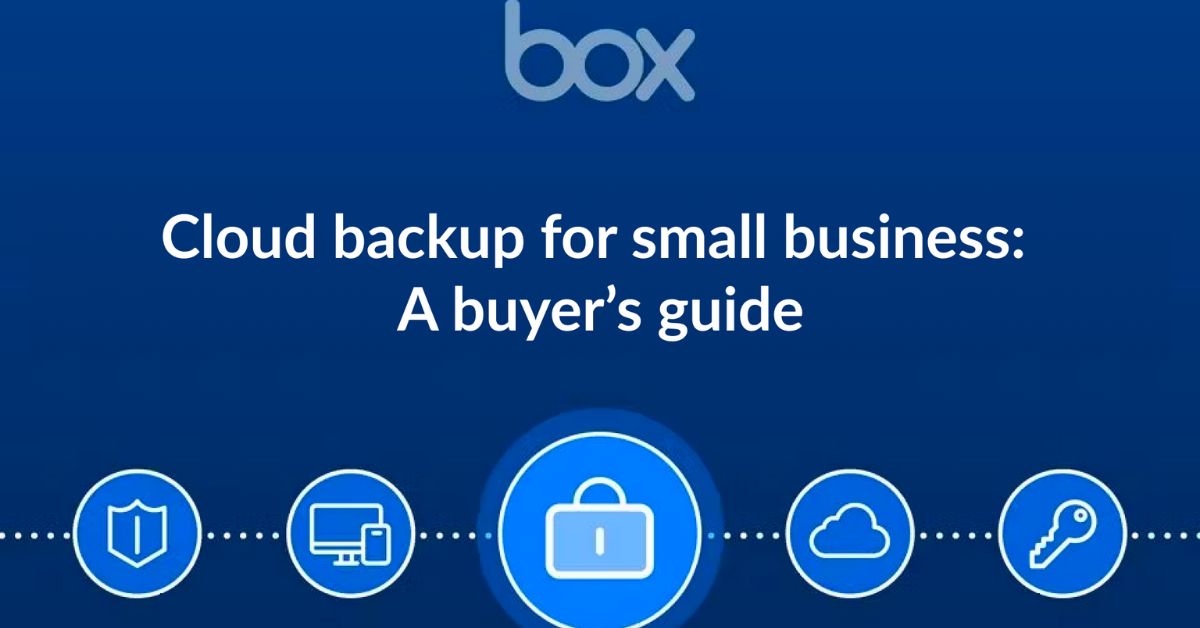BUSINESS
Cloud Data Backup for Small Business: Implementation Guide

Introduction
A local coffee shop loses a week of sales data when the cashier’s laptop crashes. A home‑based designer loses her client files after a flood ruins her desktop. These stories feel dramatic, yet they happen to small firms every single day.
The fix is simpler than many owners think: cloud data backup for small business. Moving copies of critical files to a secure online service reduces panic, slashes downtime, and lets teams pick up where they left off, no matter what came crashing down.
Why Cloud Backup Beats Old‑School Methods
Flash drives and external hard disks feel handy, but they share two big flaws. First, they sit in the same office as your computer, so fire, theft, or spills can wipe everything out at once. Second, humans forget to plug them in. Cloud data backup for small business avoids these traps. Files copy themselves over the internet to data centers miles away.
No one must remember a cable. Most services encrypt data end‑to‑end, so even if someone intercepts the transfer, they see scrambled text, not useful information. Finally, cloud providers store copies on multiple servers. If one box fails, another box steps in. The result is layers of safety far beyond a single hard drive tucked in a drawer.
Moreover, when considering a move to cloud-based solutions, establishing a robust backup strategy often begins with migrating systems to a secure and scalable cloud environment. To facilitate this, solutions like the azure migration service often provide a structured approach to shifting data and infrastructure to the cloud, forming part of a comprehensive, platform-agnostic backup and recovery plan.
Setting Clear Goals Before You Shop
Jumping straight into signup screens can cause headaches. Start by answering three short questions:
- What must stay safe?Think accounting databases, customer invoices, design drafts, and HR files.
- How quickly do we need those files back?A bakery can wait a day for archived recipes, but not for today’s orders.
- How long must we keep old records?Tax laws often require seven years; medical offices need even longer.
Writing goals on paper will guide every choice that follows. You now have the north star for your cloud data backup for small business plan.
Choosing the Right Backup Type
Cloud services come in three main flavors:
File‑level backup copies chosen folders—great for documents and photos.
Image‑based backup snaps the whole computer, system files included, letting you restore a machine exactly as it was.
Hybrid backup keeps a copy on a local device for quick restores and another in the cloud for disaster recovery.
Most offices begin with file‑level because it is cheap and simple. As the company grows, adding image‑based or hybrid layers gives deeper protection. Whichever path you pick, make sure the provider calls their plan “automatic” or “scheduled.” Manual uploads defeat the purpose of cloud data backup for small business.
Evaluating Providers: Key Factors
There are dozens of vendors, from household names to niche specialists. Compare them on these points:
- Storage limits and cost— Some plans charge per gigabyte; others offer unlimited space at a flat rate. Estimate file sizes to avoid surprise bills.
- Security standards— Look for end‑to‑end encryption, two‑factor login, and compliance badges such as SOC 2 or ISO 27001.
- Backup frequency— Near‑real‑time syncing means new edits upload within minutes. Daily or weekly schedules may suffice for static archives.
- Restore options— Can you download one file from a web browser? Will the company mail a loaded drive for huge recoveries?
- Support hours— Small businesses often work late. A 24/7 help line beats nine‑to‑five chat widgets.
When a provider checks these boxes, chances are good they can handle cloud data backup for small business without drama.
Preparing Your Data for the First Backup
Backing up messy folders wastes time and space. Perform a quick cleanup:
- Delete duplicates— Remove extra copies of photos and PDFs.
- Archive rarely used files— Zip and label large but important items.
- Organize folders logically— Use clear names like “Invoices 2025” or “Product Photos RAW.”
A tidy structure speeds the first upload and makes future restores painless. Remember, neatness today powers smoother cloud data backup for small business tomorrow.
Setting Up the Service
Installation usually takes under an hour:
- Create the accountwith a strong, unique password. Add two‑factor authentication immediately.
- Download the desktop agentfor each computer or, for servers, install the correct agent version.
- Select backup sources— tick folders, databases, or entire drives based on earlier goals.
- Choose a schedule— continuous for live workstations, nightly for servers, weekly for archives.
- Set bandwidth limitsif daytime internet speeds matter. Most apps offer a throttle slider.
- Start the initial backupand let it run. First uploads may take hours or even days.
Once the green check mark appears, your cloud data backup for small business is officially live.
Testing Your Restore Plan
A backup is only useful if you can pull files back quickly. Schedule a quarterly test:
- Pick one random folder, delete it locally, and restore from the cloud.
- Time the retrieval. Note any hiccups.
- Keep a simple checklist of steps, so anyone can follow if the tech lead is out sick.
This drill builds confidence and exposes gaps before real trouble strikes—essential for reliable cloud data backup for small business.
Automating Alerts and Reports
Most services can email a daily or weekly summary: how many files backed up, how much space remains, and whether errors occurred. Turn these alerts on. Some providers even send push notifications to a phone app. Quick awareness lets you fix problems—like a stalled agent—before they snowball. Automation ensures the owner does not need to babysit cloud data backup for small business yet still knows everything is humming.
Integrating Mobile Devices and SaaS Apps
Laptops are not the only risk. Phones store contact lists and photos; SaaS platforms hold customer chat logs and project docs. Many cloud vendors offer add‑on modules that pull mobile data or sync popular services such as Microsoft 365, Google Workspace, or Slack. Extending coverage turns scattered assets into one unified cloud data backup for small business umbrella.
Managing Access and Roles
Data safety is not just about storage—it is also about who can reach it. Create separate user accounts for each employee. Grant read‑only rights unless a person truly needs delete permissions. Remove accounts the same day someone leaves the company. Most breaches stem from weak access controls, so locking these down completes your cloud data backup for small business defense.
Optimizing Bandwidth and Costs
Small offices often share one broadband line between browsing, video calls, and backups. Two tweaks keep uploads from clogging pipes:
- Enable bandwidth throttlingduring office hours.
- Turn on block‑level backupso only the changed parts of big files transfer.
As for cost, review usage every six months. If storage keeps ballooning, archive inactive projects to cold storage tiers that cost less per gigabyte. Smart tweaks preserve both speed and the budget allocated to cloud data backup for small business.
Planning for Growth
A firm with three employees today may count thirty in three years. Choose a provider that scales easily. Seek “per‑user” or “per‑device” plans that let you add seats without switching tiers. Verify that the service supports servers, virtual machines, and NAS appliances in case your tech stack matures. Forward‑thinking now prevents a painful migration later—and keeps cloud data backup for small business seamless through each stage of expansion.
Creating a Written Policy
Documenting procedures may sound boring, yet one clear page saves chaos when nerves run high. Include:
- Backup goals and scope
- Provider name and contact number
- Folder paths under protection
- Schedule of backups and tests
- Steps for restore
- Roles and responsibilities
Store a copy both on‑site and in the cloud vault. A written policy turns cloud data backup for small business into an official part of operations, not a loose habit.
Training Your Team
Even automated systems need human respect. Hold a short lunch‑and‑learn:
- Explain why backups matter, using stories your crew can relate to.
- Show where to find the restore button.
- Encourage immediate reporting of lost laptops or corrupt files.
When everyone feels responsible, the health of cloud data backup for small business rises dramatically.
Monitoring Security Trends
Cyber‑attacks evolve fast. Subscribe to the provider’s security bulletin. Follow basic hygiene: update software patches, rotate passwords yearly, and run antivirus scans. If news breaks about a new ransomware wave, double‑check that backups run correctly. Staying alert safeguards the trust placed in cloud data backup for small business.
Common Mistakes to Avoid
- Backing up only once— Continuous or scheduled backups prevent missing yesterday’s edits.
- Ignoring mobile data— Lost phones can leak vital info.
- Keeping the default password— Hackers know those defaults.
- Forgetting restore tests— Discovering errors during an emergency is too late.
Dodging these pitfalls keeps cloud data backup for small business resilient year after year.
Real‑Life Success Snapshot
Emma, owner of BrightPrint Design, thought Dropbox was enough until a ransomware attack encrypted her entire art library. Luckily, six months prior she had adopted a dedicated cloud data backup for small business solution with version history. Within an hour she rolled back to clean copies, invoiced clients on time, and paid zero ransom. The episode cost her no more than a short lunch break and reinforced her decision to invest early.
Conclusion
Disasters rarely send warnings, but preparation flips their script from tragedy to minor speed bump. By defining goals, picking the proper service, cleaning data, and testing restores, any entrepreneur can shield valuable information. The steps are not difficult, yet the payoff—steady operations, calm teams, loyal customers—is enormous. Adopt cloud data backup for small business today, and tomorrow’s surprises will feel a lot less scary.
BUSINESS
How Often Should You Visit the Dentist? Insurance-Friendly Tips

General Recommendations for Dental Visits
How often you need to visit the dentist isn’t always clear-cut. The long-standing rule was to see your dentist two times a year for checkups and professional cleanings. This twice-yearly schedule promotes early detection of dental concerns, such as tooth decay, gum disease, and oral cancer, making treatment easier and less invasive. By catching problems before they can worsen, you can often avoid more complex and expensive procedures.
For those with chronic conditions, such as diabetes, or a past incidence of cavities and gum disease, dental professionals often suggest more frequent check-ins, sometimes every three to six months. This shorter interval allows your dentist to closely monitor healing, disease progression, and the effectiveness of your home care routine. Many dental insurance policies, especially comprehensive options like Delta Dental PPO insurance in Florida, are designed to support regular preventive care, making it easier to stick to the right schedule without unexpected costs. If you’re unsure how often you should go, talk with your dentist about individual risk factors and how other health issues, such as pregnancy or medication use, may influence your needs.
Factors Influencing Visit Frequency
Your unique health profile determines how often dental appointments should be booked. Consider these influencing elements:
- Oral Health Status: Past or current dental problems, such as recurring tooth decay, enamel erosion, or gum disease, require closer monitoring. Some patients are more prone to cavities or periodontal disease due to genetic factors, medications, or underlying medical conditions.
- Overall Health: Illnesses like heart disease and autoimmune conditions may necessitate more frequent dental oversight. Evidence shows a strong connection between oral and systemic health; conditions like diabetes can influence gum health, so regular dental evaluations are essential.
- Lifestyle Choices: Smoking, high sugar intake, and poor oral hygiene increase the risk of issues and warrant more regular exams. If you suffer from dry mouth due to medications or treatment (like radiation therapy), you may also be at higher risk for oral health problems.
For those at low risk, which means you practice good oral hygiene, have no history of dental disease, and maintain a balanced diet, annual or twice-yearly visits may suffice. Always consult your dentist to determine an individualized care plan based on these factors, and don’t hesitate to ask about what schedule best fits your life and health status.
Maximizing Dental Insurance Benefits
Dentists urge patients to make the most of their dental insurance coverage, which can significantly impact treatment decisions and costs. Many often leave benefits unused, potentially missing out on essential preventive care that their plan covers. Here are effective ways to maximize your benefits:
- Stay In-Network: Choose a provider within your insurance’s network for lower co-pays, as insurers have pre-negotiated rates with participating dentists. Out-of-network care often means higher out-of-pocket costs, so consult your insurance portal to find a suitable dentist.
- Strategic Treatment Planning: If you need extensive dental work, consider spreading treatments over the end and beginning of two calendar years to take advantage of annual benefit resets. By doing this, you may be able to use two years’ worth of benefits to cover procedures, reducing your expenses.
- Utilize Tax-Advantaged Accounts: Flexible Spending Accounts (FSAs) and Health Savings Accounts (HSAs) can be used to pay for eligible dental expenses with pre-tax dollars; track deadlines to avoid losing unused funds. These accounts are especially valuable if your plan limits covered treatments or you need elective procedures.
Review your insurance benefits annually and discuss with your dentist to optimize preventive and necessary care. Many dentists will even help you navigate paperwork to ensure your treatment is as affordable as possible, so don’t hesitate to ask their office staff for guidance.
Preventive Care: A Cost-Effective Approach
Preventive dentistry is your best defense against high dental costs and health problems. Regular dental cleanings and examinations can help catch cavities, gum problems, and oral cancers before they progress. Early detection leads to simpler, less invasive, and less expensive treatments. Most dental plans cover these visits at 100%, making them the most cost-effective way to maintain oral health. Even if you’re paying out of pocket, prevention is much lower than the cost of treating problems left to worsen over time.
Preventive Services Often Covered
- Professional cleanings to remove hardened plaque and tartar that brushing alone can’t reach
- Examinations and X-rays to reveal hidden cavities or bone loss that may be missed during a visual inspection
- Sealants and fluoride treatments for children, and sometimes for adults at greater risk for cavities, to strengthen tooth enamel and prevent decay
Routine dental care can prevent costly interventions and more serious health issues later. Untreated gum disease, for instance, has been linked to heart disease, stroke, and complications during pregnancy, making prevention invaluable to your overall well-being.
Addressing Dental Anxiety
Anxiety about dental visits is common, but avoiding the dentist only increases the risk of serious issues. Millions of Americans delay or skip dental care due to fear, but modern dental practices offer solutions to make visits more comfortable and stress-free. By addressing dental anxiety head-on, you protect yourself from escalating problems and ensure that minor concerns stay manageable.
- Open Communication: Share your concerns with your dentist so your care team can accommodate your needs. Many offices are experienced in working with anxious patients and will explain procedures in detail and work at your pace.
- Relaxation Techniques: Deep breathing, visualization, or calming music can greatly reduce stress. Many providers now offer amenities like headphones or blankets to help you relax during treatment.
- Sedation Dentistry: For patients with severe anxiety, sedation options can ensure a more positive experience. Whether it’s minimal sedation with “laughing gas” or deeper sedation for lengthy procedures, your dentist can discuss options to help you feel comfortable and safe.
Prioritizing your mental comfort empowers you to keep up with essential dental visits. Remember, every positive experience at the dentist makes the next one easier, and your dental team supports you every step of the way.
Alternative Options for the Uninsured
If you’re uninsured, affordable dental care is still within reach. Many resources are available to provide essential care and support good oral health, even when traditional dental insurance isn’t an option. Proactive oral care and regular checkups can save you money in the long run by preventing emergencies and avoiding complicated treatments.
- Dental Schools: Clinics at Dental schools offer treatments supervised by faculty at much lower costs. Students perform procedures as part of their education, all under the close watch of experienced instructors. While appointments may take longer, the savings can be substantial, and you’ll still receive high-quality care.
- Community Clinics: Nonprofit and government-funded clinics provide sliding fee scales based on your income. These clinics exist in many communities and cover a range of services, from cleanings and fillings to emergency tooth extractions.
- Discount Plans: Dental discount membership plans grant access to reduced rates for an annual fee.
With a little research and planning, you can find practical options to sustain your oral health even without insurance. Don’t let a lack of coverage keep you from seeking dental care; oral health is essential to overall wellness and can be managed with creativity and resourcefulness.
Conclusion
Individual needs—not just tradition—determine the best dental visit schedule. Regular, preventive appointments are invaluable to lifelong oral health, early problem detection, and cost savings. Whether you have traditional insurance, a dental PPO plan, or no coverage, prioritize your dental health and use available benefits or alternatives wisely. Consult with your dentist to customize your oral care routine and keep your smile healthy for years to come. Committing to proactive and preventive care pays dividends throughout your life and helps you avoid unnecessary pain or expense down the line.
BUSINESS
Exploring the Secrets Behind XRP Prices in the UK

In the wave of digital currencies, xrp price uk, as a highly anticipated cryptocurrency, has always attracted the attention of many investors due to its price trend in the UK market. Below, we will delve into the trend of XRP prices in the UK market.
Introduction to XRP
XRP is the fundamental currency of the Ripple network, which can circulate throughout the entire Ripple network with a total quantity of 100 billion and gradually decreases with increasing transactions. Ripple is an open payment network designed to address the slow and costly cross-border payments in traditional financial systems. XRP has a certain user base worldwide due to its efficient transaction speed and low transaction fees. In the UK, with the continuous development of the digital currency market, XRP has gradually entered the view of investors.
Historical trend of XRP prices in the UK market
Looking back at the past few years, the XRP prices in the UK market have experienced significant fluctuations. In the early stages, due to the overall development of the digital currency market, XRP prices were relatively low and had small fluctuations. With the increasing market awareness of digital currencies and Ripple’s continuous expansion in the payment field, XRP prices are gradually rising. During the digital currency bull market from late 2017 to early 2018, XRP prices reached historical highs. However, the market subsequently entered a bear market, and XRP prices also dropped significantly. In recent years, its price has fluctuated within a certain range, influenced by various factors such as market supply and demand, macroeconomic environment, and regulatory policies.
Factors affecting the price trend of XRP in the UK market
From the perspective of market supply and demand, if the demand for XRP in the UK market increases while the supply remains relatively stable, prices tend to rise; Otherwise, it will decline. The macroeconomic environment also plays an important role. When the economic situation is unstable, investors may shift their funds to safe haven assets such as digital currencies, thereby driving up XRP prices. In terms of regulatory policies, the UK’s regulatory attitude and policy changes towards digital currencies will directly affect market confidence. If regulatory policies tighten, it may lead to investors selling XRP and causing prices to fall; Loose policies are conducive to price increases. In addition, Ripple’s business development, technological innovation, and cooperation with financial institutions will also have an impact on XRP prices.
Future trend outlook
Looking ahead, the XRP price trend in the UK market is full of uncertainty. On the one hand, if Ripple can make more breakthroughs in the payment field, cooperate with more financial institutions, and maintain relatively loose digital currency regulatory policies in the UK, then XRP prices are expected to rise. On the other hand, the competition in the digital currency market is fierce, and new competitors are constantly emerging, which may have an impact on XRP’s market share. Meanwhile, changes in the global economic situation and adjustments in regulatory policies may also lead to price fluctuations. Investors need to consider various factors comprehensively and make cautious investment decisions when paying attention to the trend of XRP prices.
BUSINESS
From Handshake to Handoff: Why Business Cards and Their Boxes Still Matter in Modern Branding

In an era where most interactions happen online, physical tools like business cards and business card boxes might seem outdated. But for businesses serious about branding, the handshake isn’t complete until a card is exchanged—and properly stored. Despite rapid digitalization, these tangible elements still pack a punch in first impressions, organization, and brand continuity.
Let’s break down why business cards and their custom packaging matter more than ever.
The Enduring Power of a Physical Card
The act of handing over a business card creates a tactile and memorable moment. It’s more than contact information—it’s a reflection of your brand.
- Credibility: A high-quality business card suggests trust and seriousness.
- Brand Recognition: Color, typography, and layout all reinforce visual identity.
- Networking Efficiency: In fast-paced conferences or meetings, it’s faster and more professional to hand a card than to fumble with phones.
Even with NFC tech and QR codes rising, physical business cards remain irreplaceable for many professionals. And when they’re accompanied by well-designed business card boxes, they elevate the entire experience.
What Makes a Business Card Box Essential?
Business card boxes are often overlooked, but they serve both practical and branding purposes.
| Feature | Benefit |
| Protection | Prevents bends, smudges, and wear |
| Organization | Keeps multiple styles or contacts separated |
| Presentation | Gives a professional touch during handover |
| Branding Surface | Offers logo space for subtle marketing |
| Bulk Utility | Useful for tradeshows, sales teams, and events |
For B2B industries—where first impressions matter most—custom business card boxes can serve as silent brand ambassadors.
Designing for Impact: Tips for Modern Business Cards
To make a card that lands well, keep these tips in mind (especially if you’re opting for a standard playing card size, which is popular for creative business card designs):
- Use durable materials like 16pt or 18pt stock with matte or glossy finishes.
- Consider embossing, foil stamping, or spot UV for texture.
- Keep designs minimal but branded—colors, icons, and fonts matter.
- Add QR codes that link to portfolio, website, or LinkedIn.
Cards may be small, but their influence is large when the design aligns with the brand’s values. Combined with well-matched business card boxes, you ensure brand consistency from creation to presentation.

Who Needs Custom Business Card Boxes?
Custom boxes aren’t just for storage—they’re an extension of your professional story. Here’s where they shine:
| Industry | Use Case |
| Real Estate | Client meetings, open house handouts |
| Consulting Firms | Brand authority in corporate networking |
| Design Agencies | Creative presentation of contact info |
| Event Planners | Quick access to cards for vendor communication |
| Tech Startups | Pitch sessions and launch event handouts |
Having a box that holds your cards cleanly and stylishly reflects foresight and attention to detail—values every client respects.
Common User Questions Answered Naturally
- “Why do people still use business cards?”
- “How to store business cards professionally?”
- “Are business card boxes useful for networking?”
- “Best packaging for business cards”
All terms are answered conversationally to meet Google’s EEAT and voice search intent.
Why Custom Packaging Pro is the Smart Choice
If you’re looking for a partner to help you make lasting impressions, Custom Packaging Pro delivers:
- Custom-sized business card boxes with premium finishes
- Durable materials for both card protection and presentation
- In-house designers to help match your box with your branding
- Bulk discounts and reliable delivery for B2B teams
Whether you’re rebranding, launching, or attending an expo, CPP helps your brand show up sharp—card and box in hand.
FAQs
Q: Are business cards still relevant in 2025?
A: Yes! Physical business cards are still widely used in professional networking and leave a lasting impression.
Q: What are business card boxes used for?
A: They protect, organize, and elevate the presentation of your business cards.
Q: Can I get custom printed business card boxes?
A: Absolutely—companies like Custom Packaging Pro offer full customization options.
Q: What should I look for in a professional business card?
A: Durable material, clean design, brand consistency, and maybe a QR code for digital linking.

Conclusion
Even in the digital age, business cards—and the boxes that store them—deliver unmatched value in networking, branding, and presentation. For B2B professionals and growing brands, they’re a small but mighty investment. Partner with Custom Packaging ProF to create business card packaging that speaks before you say a word.
-

 TECHNOLOGY2 years ago
TECHNOLOGY2 years agoElevating Game Day Eats: A Guide to Crafting Crowd-Pleasing Sliders
-

 ENTERTAINMENT2 years ago
ENTERTAINMENT2 years agowave_of_happy_: Your Ultimate Guide
-

 FASHION2 years ago
FASHION2 years agoGPMsign Fashion: Redefining Style with Purpose
-

 TECHNOLOGY1 year ago
TECHNOLOGY1 year agoTrader Joe’s Dayforce: Revolutionizing Workforce Management
-

 FOOD2 years ago
FOOD2 years agoAltador Cup Food Court Background: A Culinary Extravaganza Unveiled
-

 SPORTS2 years ago
SPORTS2 years agoScore Chaser Sporting Clays: A Thrilling Pursuit of Precision
-

 HOME IMPROVEMENT1 year ago
HOME IMPROVEMENT1 year agoWhat Kitchen Renovation Companies Offer Beyond Basic Remodeling
-

 NEWS2 years ago
NEWS2 years agoNyl2 Kemono: Unveiling the World
